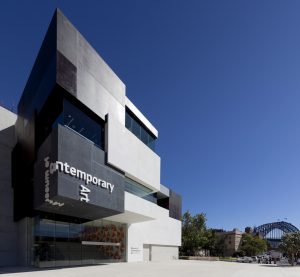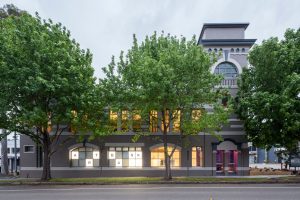Artist Jessica Fesic
with Rowen Talacko,Artbank Curatorial Assistant at Artbank in May 2015. Artwork by MarcdeJong 'Death Star' 2007. Photo: Kristina Tito, Accessible Arts.
Last week M&G NSW took the lift up to Level 3 in The Arts Exchange to talk to our new neighbours, Accessible Arts. We sat down with Sarah Houbolt, the Access and Training Project Manager, and Kris Tito, Arts Development Manager to learn a bit more about what the organisation offers.
M&G: Access is a broad area; can you describe what you and Accessible Arts do?
SH: As the Access and Training Project Manager at Accessible Arts, I organise general disability awareness training as well as specific tailor-made training for organisations.
I also provide and arrange specialised access services such as disability action plan consultation, access appraisals and services such as audio description, sign interpreting, and captioning.
Accessible Arts NSW focuses on excellence in arts and disability. We’re the “go-to” organisation for advice and information on how to develop arts programs that welcome and support people with disability; how to make sure people with disability enjoy their arts experience; and how to build your organisation’s capacity to work with and promote events and activities to a diverse community.
M&G: Here at M&G we support a number of small and volunteer organisations that effectively operate without budgets. In your opinion what are the most important aspects of access for these organisations?
SH: Customer service and good communication is everything! These are things which cost nothing yet bring rewards: economically for the organisation and experientially for the visitor.
Our disability awareness training explores how to make people feel welcomed, supported and valued: by showing respect, asking not assuming, and through a little bit of thoughtful and informed decision-making.
There are also lots of tricks of the trade that make the world of difference to patrons with disability – the height of exhibited items, how close you can get them; whether a staff member can verbally describe the art work; where objects are placed and located; what colours and language is used in signs and promotions; use of smart phone technology; and importantly, how staff deal with misunderstandings which sometimes result from having different expectations.
The cool thing is that we are in a sector of really creative thinkers, so we are skilled at finding creative solutions alongside our commitment to working incrementally towards access standards.
M&G: Catering for people with disabilities is generally considered ‘the right thing to do’. However, it’s often last in the list of priorities and consequently implemented in a patchwork fashion. Is solving this simply a matter of time or are other actions warranted?
SH: No, the solution lies in making time for this, and you will actually find that by making time for innovation, you will see positive exponential effects for your organisation.
Securing access is not only a legal requirement but it also means that your audience numbers will increase – if you do the work, then people with disability will have an enjoyable and enriching experience–which is great–and in turn will minimise the risk of potential bad publicity.
Your other audience segments will benefit from an access approach too – mothers with prams, migrants and international tourists for example.
A patchwork approach however is reactive and unplanned, whereas an incremental approach is about having a realistic disability action plan. Solving bigger capacity issues is about working smarter and finding the information you need to make good decisions.
When people with disabilities are viewed as assets it’s easier to plan an exciting and innovative way forward.
M&G: Assisting artists with access to facilities in which they can create is something you take very seriously. Can you describe the Supported Studio Program and some of the work developed through the program?
KT: Yes, it is something we take seriously. We believe that art and culture is essential and that people with disability need the same access to community and professional art-making experiences and opportunities.
Supported studios are an emerging and important part of the ecology of contemporary visual arts practice in Australia. Supported studios enable people with learning disability opportunities to develop as professional visual artists.
They support artists in navigating and connecting with career building opportunity and experiences in the broader arts sector. The Supported Studio Network (SSN) is an initiative of Accessible Arts, and has developed into a national body to build capacity, provide resources and strengthen connections so that diverse supported-studio models can be sustained.
Have a look at the website: aarts.net.au/supportedstudios
M&G: Accessible Arts offer Disability workshops regularly throughout the year. What are the benefits of this training?
SH: The training brings together people from the arts and cultural sectors to learn about and explore creative ways to provide excellent customer service and specialised access services.
Disability awareness training is important for all staff members and volunteers and encourages reflection on work practices and breaking myths bout disability. The training helps organisations keep their competitive edge by staying up to date with new ideas, new language, and innovative solutions.
We also deliver training regionally upon request and can tailor-make training workshops according to need. The benefit of going to an Accessible Arts workshop is that we have both broad arts and disability knowledge. Our next workshop is 12 August in Sydney.
M&G: Accessible Arts offers a DIAP (Disability Inclusion Action Plan). Can you describe how it works and what the benefits are for a museum or gallery?
SH: A disability inclusion action plan is an important step for organisations to work towards legal requirements and good business planning.
We work with you to create a plan that is realistic, informed and achievable in a museum or gallery context whether you are in the city or the country, whether you are small or large. It’s essentially a road map to achieve various levels of access and inclusion for your patrons, audience, customers and co-workers with disability.
We can help you review your plan over time, evaluate your progress or even make an initial access appraisal if you are not sure where to start.
We live in an exciting time where there is a critical mass of voices asking for access and inclusion, and a critical mass of organisations responding. More information is on our website.
M&G: If you had gold stars to award for Access achievements, which organisations would you award one to?
KT: The Museum of Contemporary Art is doing great things on a physical and program access base context.
The MCA are creating mentorship and creative exchange opportunities within its Bella Plus program for people with disability or living with injury. They recently received funding from ArtsNSW to support the rollout of a new mentorship project, which will see the professional development and social integration of artists and artist educators with and without disability.
Also just recently, Artbank received funding from the strategic Arts NSW Arts and Disability Initiative between Family and Community Services and ArtsNSW to support the inclusion of visual artists with disability in their programming.
In 2015-2016 Artbank will acquire, commission and include in their curatorial program and Sturgeon publication, artworks by artists with disability from supported studios, but also artists working independently throughout NSW. This is really an exciting career building opportunity for artists with disability in NSW . . . it’s a watch this space!
Accessible Arts has been providing support to both the MCA and Artsbank in order to elevate the artistic practice and contributions that visual artists with disability make to contemporary arts practice in Australia.





